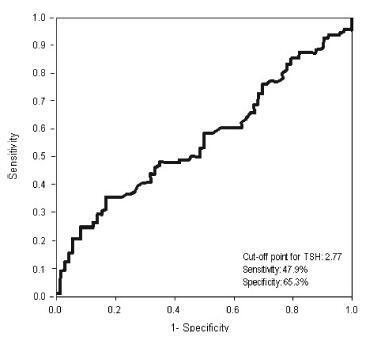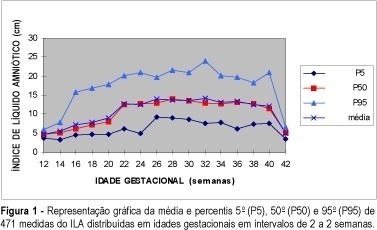Summary
Revista Brasileira de Ginecologia e Obstetrícia. 2009;31(5):224-229
DOI 10.1590/S0100-72032009000500004
PURPOSE: to identify the pattern of myoelectrical activity of muscles from the scapular region, after axillary lymphadenectomy in breast cancer. METHODS: prospective cohort study including all the women submitted to axillary lymphadenectomy for surgical treatment of breast cancer, in a breast cancer reference center, from June to August 2006. The women were evaluated before, and after 3 and 12 months from the surgery, through physical and electromyographic examinations of the serratus anterior, upper trapezius and middle deltoid muscles. RESULTS: the patients' average age was 60.3 years old (DP±14.1), and the incidence of winged scapula at the physical examination was 64.9%. At the third-months evaluation, a reduction of 28.3 µV was observed in the myoelectrical activity of the serratus anterior muscle. At the twelveth-months evaluation and between the 3rd and the 12th month, there was an increment of 23.3 µV and 43.6 µV, respectively. For the upper trapezius, the increase was of 23.1 µV at the third-months evaluation, and 23.3 µV and 43.6 µV between the 3rd and the 12th months. As compared to before the surgery, the evaluation of the middle deltoid muscle did no present significant differences. CONCLUSIONS: considering muscle activity evaluated by surface electromyography, there was a decrease in the myoelectrical activity of the serratus anterior, due to lesion of the long thoracic nerve (neuropraxia), in the immediate postoperative evaluation. The increase of the mean square root of the electromyographic signal of the upper trapezius muscle, since the preoperative evaluation, suggests a muscular compensation related to the serratus anterior muscle's deficit.
Summary
Revista Brasileira de Ginecologia e Obstetrícia. 2017;39(5):224-228
This study analyzed the effectiveness of the thyroid-stimulating hormone (TSH) as a predictor of insulin resistance (IR) and its association with the clinical and metabolic parameters of women with polycystic ovary syndrome (PCOS) without overt hypothyroidism.
A cross-sectional study was performed. Women with PCOS and without overt hypothyroidism (n = 168) were included.
Receiver operating characteristic (ROC) curve was used to determine the cut-off point for TSH that would maximize sensitivity and specificity for a diagnosis of IR using homeostatic model assessment of insulin resistance (HOMA-IR)≥ 2.71. Clinical and metabolic parameters were compared as a function of the TSH cut-off limit and the presence of IR.
Thyroid-stimulating hormone ≥ 2.77 mIU/L was associated with a diagnosis of IR, with sensitivity of 47.9% and specificity of 65.3%. There were no differences in clinical, hormonal or metabolic parameters between TSH < 2.77 and TSH of 2.77 - 10 mIU/L.
In women with PCOS without overt hypothyroidism, TSH ≥2.77 mIU/L is associated with IR; however, with poor sensibility, showing TSH to be a poor predictor of IR in this population. No clinical or metabolic alterations were found that would justify a change in clinical management. Thus, the IR should be investigated in all women with PCOS irrespective of TSH level.

Summary
Revista Brasileira de Ginecologia e Obstetrícia. 2008;30(5):224-231
DOI 10.1590/S0100-72032008000500004
PURPOSE: to analyze the association of pregnancy in adolescence with low birth weight (LBW). METHODS: all the patients who gave birth in a teaching Hospital at Maranhão State from July to December 2006 were included in the study and were split in two groups: adolescents (ten to 19 years old) and adults (20 to 34 years old). The variables studied were: skin color, schooling, marital status, family income, number of pre-natal appointments, gestational age at the onset of pre-natal assistance, place where they spend that period, gestation duration, delivery route and birth weight. Data were processed by the Epi-Info program, 3.4.1 version, and the associations between variables were analyzed by the Odds Ratio (OR), with a confidence interval (CI) of 95%. Models of logistic regression were also used. The significance level adopted was 0.05. RESULTS: 1,978 patients were evaluated. A ratio of 25.4% of deliveries in adolescents was observed; they presented low level of schooling, no mates, low number of pre-natal appointments, late onset of pre-natal assistance, low birth weight and prematurity. In the analysis of LBW as end variable, associated to prematurity (OR=29.0), it was clear the association with low number of pre-natal appointments (OR=2.98; 95%CI=2.23-4.00), pre-natal late onset (OR=1.91; 95%CI=1.3-2.6) and low schooling (OR=1.95; 95%CI=1.4-2.5) related to adolescence (OR=1.50; 95%CI=1.1-1.9). Similar results were obtained when the prematurity variable was excluded. Adolescents showed lower incidence of caesarean section (33.3%) than adults (49.4%), a significant difference, besides lower association with pre-eclampsia and cephalo-pelvic disproportion. CONLUSIONS: pregnancy in adolescence was associated to pre-natal late onset and low number of appointments, besides low schooling, low birth weight and a lower incidence of cephalo pelvic disproportion and pre-eclampsia.
Summary
Revista Brasileira de Ginecologia e Obstetrícia. 2007;29(5):225-229
Summary
Revista Brasileira de Ginecologia e Obstetrícia. 2001;23(4):225-232
DOI 10.1590/S0100-72032001000400005
Purpose: to determine the amniotic fluid index (AFI) through ultrasound assessment in normal pregnancies and produce a curve of normalcy for the AFI from the 12th up to the 42nd week of pregnancy. Methods: the study involved 471 measurements on 256 pregnant women, all undergoing normal pregnancies. In pregnancies of more than 20 weeks an estimation was made of the sum of the largest vertical diameters of the amniotic fluid pockets in the four quadrants into which the uterus was divided. In the pregnancies of 20 weeks or less, the sum was obtained from the largest vertical diameters measured in the two halves into which the uterus was divided. Results were expressed in centimeters. Results: AFI was measured (471 measurements) and the results were stratified and grouped by weeks of pregnancy (every two weeks), except the 12th week which was analyzed alone. From an average of 4.7 cm (limits 3.8-5.9 for the 5th and the 95th percentiles) at the 12th week of pregnancy, the AFI grew progressively up to the maximum mean of 14.6 cm at the 32nd week (limits: 7.0-2.5 cm). AFI presented stable measurements from the 21st up to the 40th week. After that, AFI measurements suffered a sharp decrease. The AFI cutoff point occurred at the 21st week of pregnancy. The percent increase of AFI obtained at the 32nd week, when compared to the 12th was 197.7%, and 2.9% at the end of pregnancy when compared to the measurement of the week taken as reference. Conclusion: AFI varied during pregnancy. It increased progressively up to the 21st week and then stabilized up to the 40th week. After that, it experienced a sharp decline. The maximum measurement of the AFI occurred at the 32nd week. By establishing a normalcy curve for AFI it becomes easier to detect changes and allows for a better follow-up of the pregnancy period.

Summary
Revista Brasileira de Ginecologia e Obstetrícia. 1998;20(4):225-225
DOI 10.1590/S0100-72031998000400010
Summary
Revista Brasileira de Ginecologia e Obstetrícia. 1998;20(4):225-225
DOI 10.1590/S0100-72031998000400009
Summary
Revista Brasileira de Ginecologia e Obstetrícia. 2000;22(4):225-228
DOI 10.1590/S0100-72032000000400006
Purpose: to analyze the frequency of glove perforation during gynecologic surgeries. Methods: a prospective study of 454 gloves used in 65 surgeries by the water pressure method. Results: of a total of 454 gloves, 54 (11.9%) had perforations. Comparison with the control group showed p<0.05 (chi² test), 1 (1.7%) perforation in 60 gloves tested. Of the total of gloves used in 65 surgeries, 29 (44.6%) had perforations, 44 (81%) had one perforation and 10 (19%) had more than one perforation. The two most common sites of perforations were the index finger, 20 (29.5%) and the thumb, 14 (25.9%). Perforation was predominant in the left hand (72.1%). The surgeons were the members of the team with the greatest number of glove perforations. Total hysterectomy was the most frequent surgery in which glove perforations occurred (50% of the cases). Conclusion: the glove perforations occurred with relatively high frequency during gynecologic surgeries. The index finger of the left hand proved to be the most affected region. Among the members of the team, the highest percentage of glove perforations occurred in those of the surgeons. Total hysterectomy had the highest perforation rate.